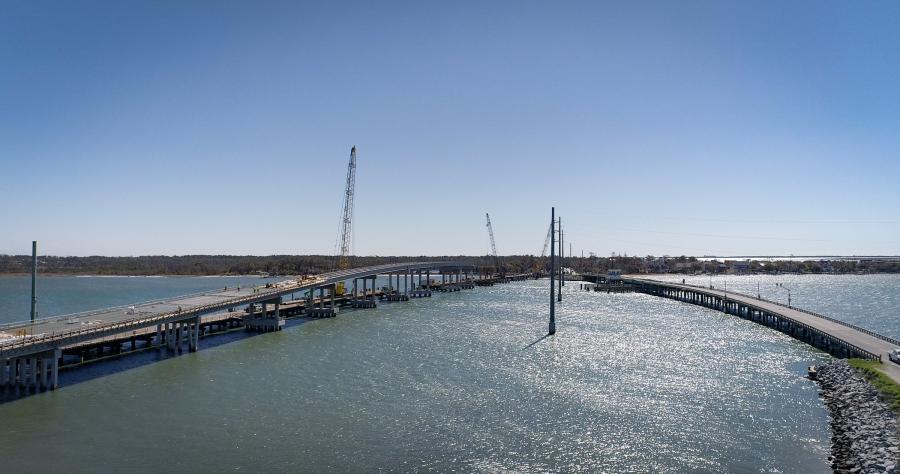NCDOT working to replace 50-year-old bridge (R) using glass and carbon fiber reinforcement (L) in Harkers Island. (NCDOT photo)
Exciting things are on the horizon for North Carolina's transportation future.
The North Carolina Department of Transportation is replacing the Harkers Island Bridge using non-corroding, glass and carbon fiber-reinforced polymer materials.
NCDOT will replace swing-span Bridge No. 73 (Earl C. Davis Memorial) and Bridge No. 96, which together form the only vehicular link from the mainland to the island, with a fixed-span high-rise structure.
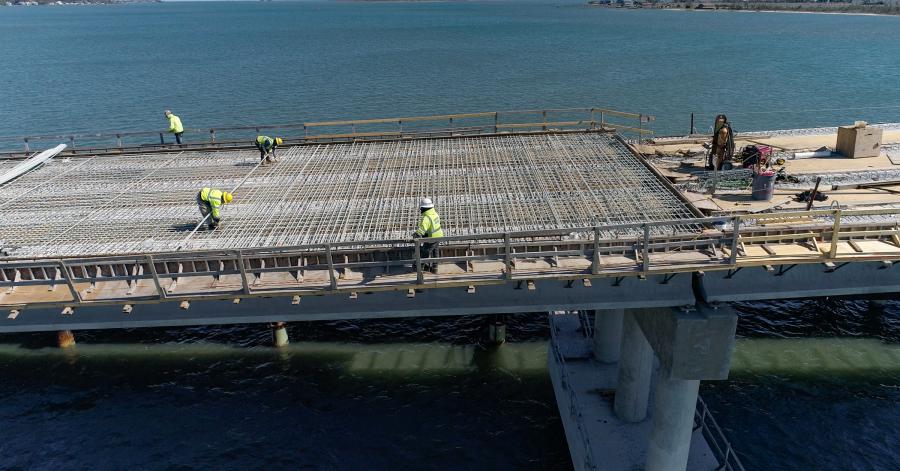
Crew members installing glass fiber reinforcing bars for the bridge deck. (NCDOT photo)
The Harkers Island Bridge will become the first fully-reinforced glass and carbon fiber bridge in the state. NCDOT expects the new design will better withstand the highly corrosive marine environment of the Carolina coast and extend the longevity of the bridge by decades.
"Typically, new bridges are designed for a service life of around 75 to 80 years," said Trey Carroll, NCDOT project engineer. "By using glass and carbon fiber-reinforcement, we can expect the new structure to have an extended service life with more than a 100 year lifespan."
Located in Carteret County on the southern end of the Outer Banks, the region locally known as "Down East," Harkers Island is a coastal gem popular amongst avid fisherman and tourists.
The island's first bridge was a wooden structure built in 1941 with a short service life of only 27 years. It was replaced in 1969 using concrete with steel reinforcement.
Previous structures have been extremely vulnerable to deterioration due to the aggressive and corrosive environment of the coastal plain. The harsh salt water causes steel-reinforced bridges to corrode at a more rapid rate, placing a hefty financial burden on NCDOT.
NCDOT resident engineer Brad McMannen said the salty environment poses a threat to traditional steel rebar.
"As far as the bridge itself — the salty water is the issue and we need to prevent the salt water from eating away at the rebar," McMannen said.
An innovative solution was needed to preserve state transportation funds and prevent further delays on the island.
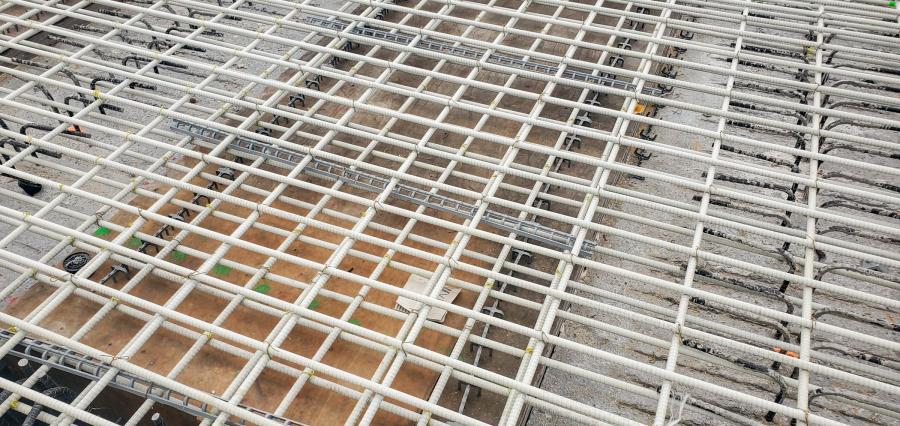
Glass fiber reinforcement for the bridge deck. (NCDOT photo)
NCDOT partnered with North Carolina State University to lead the research behind this innovative technology. An initial research project was launched in 2013 and investigated the use of non-corroding carbon fiber polymer in concrete bridge elements commonly used in North Carolina, confirming glass and carbon fiber as suitable alternatives to traditional steel reinforcement.
When asked about the efficiency of using fiber-reinforced polymer in coastal bridge replacements, NCDOT research and development engineer Mustansir Kadibhai shed light on how the new design will eliminate the corrosion and durability problems faced by previous designs.
"Because fiber-reinforced materials are not metallic, they are not prone to corrosion — which addresses the durability concern of bridges located in coastal marine environments," Kadibhai said.
The research team also addressed safety concerns, assuring residents that while glass and carbon fiber technology has recently been emerging in the transportation sector, it is no longer considered a "new" technology and is safe.
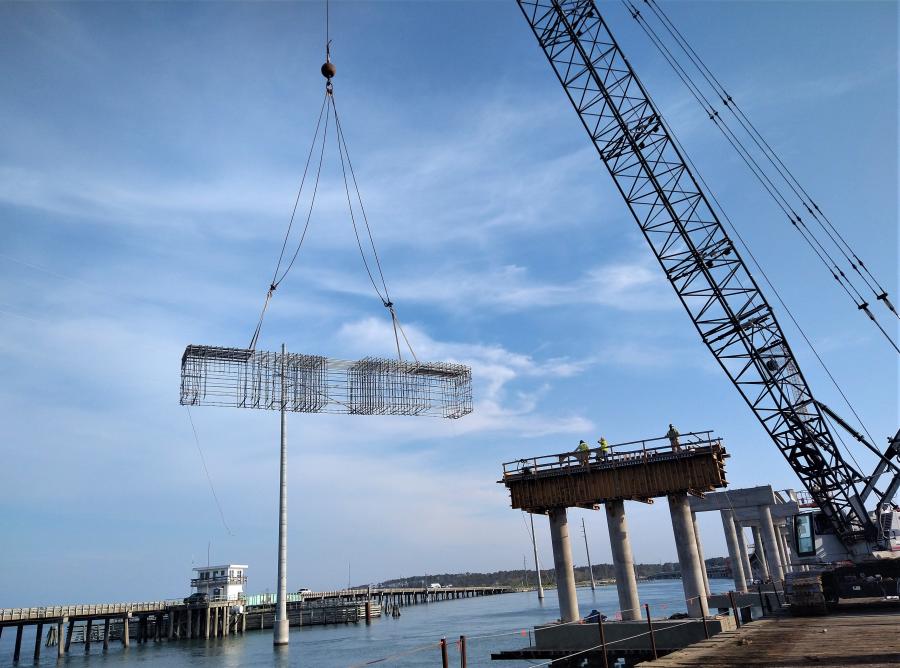
Glass-fiber reinforcement cage to be fully encased in concrete. (Balfour Beatty photo)
"There are bridges reinforced with glass and carbon fiber reinforcement worldwide that remain in service after more than 30 years," Kadibhai said. "In the United States, there are numerous bridges under design, construction or in-service that have fiber-reinforced elements and an ever-increasing number of successful field applications."
The department has codes and standards in place to ensure the safe design and construction of the bridge, layered with comprehensive quality control and quality assurance measures. The bridge design was undertaken by NCDOT structural engineers adhering to American Association of State Highway and Transportation Officials (AASHTO) design guide specifications for fiber-reinforced concrete bridges. The carbon and glass fiber-reinforcing materials were obtained from a Fiber Reinforced Polymer (FRP) Institute accredited supplier.
The new structure will benefit both the department and the local community by alleviating the financial strain caused by the 50-year-old structures.
The local economy took a hit when officials were forced to place weight restrictions on the swing-span bridge (No. 73), which limited the size of freight trucks and other commercial vehicles permitted.
The swing-span bridge is susceptible to mechanical issues, which can cause long delays or even closures that prevent boat traffic from passing through.
The community is active in the commercial fishing industry and a blocked navigational channel can be detrimental to their livelihood. With a new 45-ft. vertical navigational clearance, vehicular and vessel delays due to bridge openings and closures will be eliminated. The improved capacity will allow for better access to and from the island in the case of emergencies and hurricane evacuations.
Glass and carbon fiber-reinforcing materials are cost-effective alternatives for new infrastructure. These materials also can be used to repair existing infrastructure and extend their service life until a replacement can be budgeted and scheduled without the need for weight restrictions or bridge closures. Ultimately, state and local agencies will save money and time.
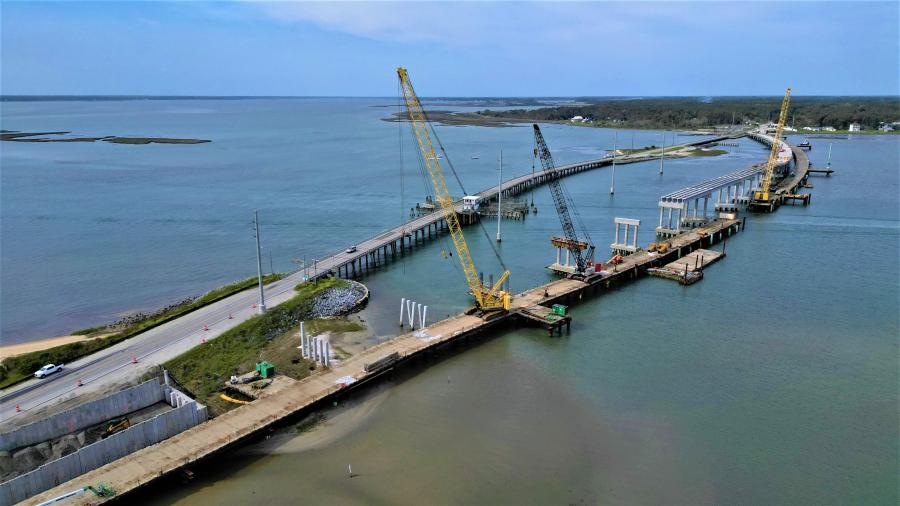
Harkers Island Bridge (L) shown beside ongoing construction of a new, glass and carbon fiber-reinforced bridge expected to be completed by fall 2025. (Balfour Beatty photo)
The Harkers Island Bridge project is a groundbreaking success for North Carolina. This project will pave the way for more advanced infrastructure technology throughout the state.
Pam Carriker, NCDOT Engineer II, spoke on the importance of working smarter, embracing innovation and learning from others.
"We are going to have to learn to work smarter, be innovative, but we also need to be sure we're capturing some of the wisdom from our seasoned employees — and make sure that we still understand why we are doing this — and continue being good stewards for the state of North Carolina."
The new Harkers Island Bridge will serve as a benchmark for future structure designs to learn and adapt from.
"NCDOT is supporting an ongoing research study at NCSU, to provide structural performance monitoring for the project so future fiber-reinforced bridge designs can be optimized," said Kadibhai.
The Harkers Island Bridge Project is a great representation of NCDOT's commitment to building more resilient, efficient and safer infrastructure to enhance the quality of lives of North Carolina residents.
Today's top stories



